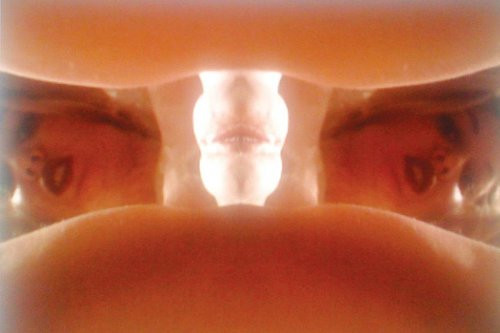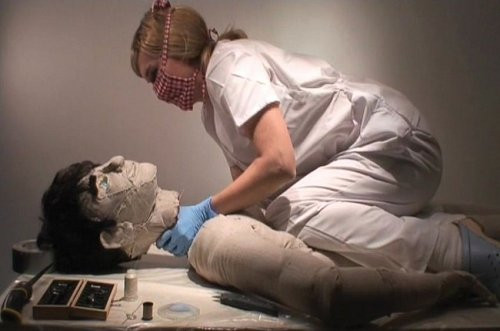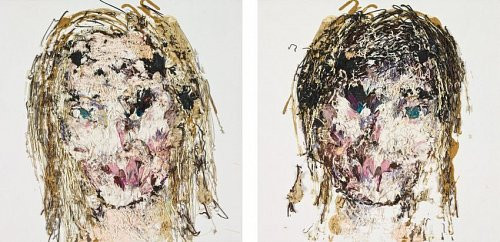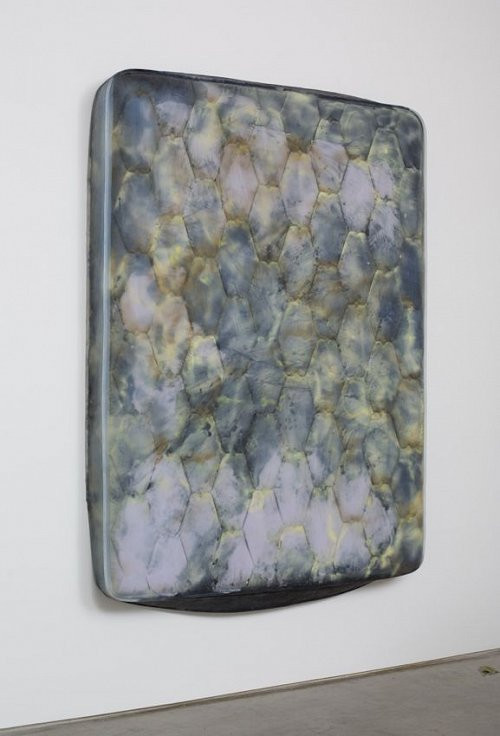Kaari Upson
Published: July, 2013, ZOO MAGAZINE #40
With the ambitious Larry Project the Los Angeles based artist Kaari Upson created a bizarre own universe in which the notions of phantasy and reality are being questioned.
Marta Gnyp: Lets start with the Larry project since it seems to have been a very essential part of your artistic practice so far. In an abandoned house in the neighbourhood of your parents, which you could watch a child as a secret place of sex parties and quasi-criminal activities, you found documents and journals of the owner whom you gave a fictive name Larry. The house burned down, you lost one of his journals and than your fantasy started to work. As from 2005 you have been creating a whole body of works including objects, installations, videos and performances that were constructed around the absent Larry and yourself. Why did you invent Larry?
Kaari Upson: I was still as student at Cal Arts in LA. I was painting and very seriously trying to understand what I could do with painting and how to do it critically. My works were super photorealistic; I was taking pictures of any crime scene with beds that were generally the places of crime of passion. So once I found the beds of Larry’s house. I went in, I got snapshots of the beds and I had painted it. I was using these grids to try to think about minimalism and to engage in this high-low debate but it wasn’t going anywhere.
MG: What other projects did you do at that time?
KU: I was trying to create an emotional map of Los Angeles. I would search where something had happened, I would go there with the camera or anything, and try to represent this sense of place and to catch the significant or insignificant memory that were somehow embedded in the space.
MG: So a lot of the aspects of the Larry-project were already there, the emotional absence, the hidden psychology of relations and memory of the space. What did you find in the house of Larry?
KU: Every room in Larry’s house other than bathroom and the kitchen had a matrass. I photographed the rooms before the house burned down. There were beds everywhere as if somebody left them very quickly, as if somebody was squatting in the space. Then I rebuilt different parts of the house, entire rooms that become kind of sculptures, which could constantly be transformed. I was doing it based on a photograph and my own memory. There would be blind spots in it that I would have to fill, but pretty much everything was reassembled and so this matrass came back, a real matrass that we cast in latex. So that started the process making this, and that was 3-dimensional because it had a front, all sides and a back.
MG: Why are you so fascinated with the matrass?
KU: There is this large aesthetic history of artists using beds like a starting point. I like engaging in this discussion in a new way. I did focus on the idea of it having four sides and a face; through that experimenting we realized that we could use silicones instead of the original latex because it is transparent. Now they are completely different and more like paintings. They don’t have a fleshy or bodily feeling to them. The gestures are all imbedded in the material now, in a way that I have to work blindly.
MG: So you have no control over the final result.
KU: If you do something long enough, you can even master chaos to a certain degree. In my Kiss Paintings, I was aggressively putting two oil paintings together as if they were kissing each other not knowing what would happen. But after working for a while, I could start understanding even how the temperature of the day was going to effect their ‘kiss’. And then as soon as I understood it I stopped making them.
MG: Are you now investigating how the silicon works?
KU: It is about a very active space involving several people at once. One person can’t make these. The material has to stay fluid but tactile. The pieces have to be started and finished in the same go and they can never be put on hold. They have to stay in a certain stage or they frieze up. It’s just the materiality of silicon, which gives it such a dynamic way of working, because it’s a team effort, and besides it is very physical.
MG: How would you describe the process?
KU: It is messy, very physical act, moving these things around, keeping these things wet. It feels like a sport. Things go wrong constantly so you can compare it athletics, the response has to be really quick. It’s very frustrating, because none of the pieces turn out as I expect, so there is no planning. Even colours change.
MG: Do you leave them like they appear?
KU: Yes. When you have time to go back like in a painting made in a traditional way it is different. Even my kiss paintings, I could remake them over and over again, I could pull them apart and put them back together. In case of silicone there is no reworking possible.
MG: Do your works function differently outside your studio?
KU: Recently I saw some of my charcoal pieces on their own in a beautiful room. In my studio they were dusty, black pieces that were surrounded by many other objects and actions. If you isolate things they will get the meaning on their own. I realize that there is something going on there, they could breath outside the warehouse, which normally dominates them. This studio is very different than any exhibition space. Sometimes curators say to me: we want this to look like your studio. But it never looks like it: once you move your studio, it’s always this slightly cleaned up version.
MG: You built a grotto that referred to the Playboy Mansion of Heffner in which you did your performances that engaged with Jungian and sex therapies. You invented characters, like Crissy and Kerry? What was yours and theirs relationship to Larry?
KU: It’s very hard to tell this story so that it makes sense. Yes, when I worked in the grotto, I followed a Jungian therapy with therapists that I could get on a speakerphone. They didn’t know that the sessions were recorded; it was really high quality speakerphone. The woman on the phone asked me about a dream I had, a very Jungian approach, and in that moment I decided to give her a real dream. I said: I had a dream about somebody whom I know from the high school. Her name was Crissy. In this dream I killed her in a very particular way: I ripped out her lymph gland from her neck and then went hiding. I was discovered as the killer while sitting in front of a TV set watching my moms face watching the TV and then realizing my mom knows I killed Crissy, I am watching her, watching the TV. In this way the starting point could be seen as personal. I don’t believe that dreams are the gateway to any imagination; I think it comes from the world we live in.
MG: What did you do with the idea of Crissy?
KU: I was in the grotto, dressed with fake breasts and a fake vagina, with the doll that hasn’t even become female yet. This woman said: “she is your shadow, Crissy is you”. I couldn’t get it out of my head because this poor girl really exists. I found her on Facebook and I actually saw a photo of her as an adult. The therapist kept telling me that I had to work through Crissy, to see my fears. So I had to constantly tell her what Christie was like, to do this Jungian shadow work. But then I moved to the drawing and started a dialogue with things that happened in the video: some of them I would forget, some of it would misremember, and some of them would merger.
MG: Did you discover why Crissy was important to you?
KU: After three months the grotto has become a place of a narcissistic self-exploration and I started thinking about my shadow and myself self as a perfect double. As Larry was obsessed with Hugh Hefner, his grotto was the starting point for my grotto. Heffner once said that every man’s deepest sexual desire is to have sex with identical twins. So here I had my twin, the doll, my perfect double. I recast my face in perfect dimension, my eyes were set in a perfect ration, my nose was cleaned up, my lips were pumped up and we made a silicon mask, became my perfect self. Crissy could then be projected into her and then I made phone calls to random sex therapists making them play with my twins.
MG: How does a sex therapy on the phone work?
KU: It’s not real sex therapy; it’s just phone sex call workers who say that they could help you through all kinds of problems. The women on the other side are paid to give a sexual scenario mostly toward men. So I think it’s just for men to have sex for three dollars a minute. I called in several times and spoke as Crissy or Kerry (they kept calling me Kerry even my name is Kaari). I recorded my sessions and found something strange going on in them that I can’t quite identify.
MG: What was so strange in this experience?
KU: Once I spoke with a woman who obviously didn’t know her voice was being videotaped and heard inside the grotto, and this conversation was very confusing. We were both were faking, so we had this weird zone where, when you don’t have a climax to go to and you keep turning it into itself. She was probably really confused that I wasn’t getting off so then of all of a sudden the scenario would be dirtier and then something would decompress and she would have to build it back up again. She kept trying to make it dirtier and dirtier, but the dirtiness was so normal, that both our imaginations couldn’t go further than what was available, which was porn.
MG: How were your performances and videos received?
KU: When the works were firstly exhibited in the Hammer Museum in LA some people were highly offended. One man said that the silicon breasts and silicon vagina were against God, because the body that God gave us was beautiful and perfect and that I was altering it. The grotesqueness and the prosthetics bothered people a lot. But I was just following what was already there: i.e. the model of Playboy’s first photo-shopped vagina. It just naturally evolved into this grotesque monster, but it was naturally dirty.
MG: I had the impression that you changed in your approach to this project, from more personal into making a clear distance to your work as artistic project.
KU: When I started this project I was advised then that I should talk about it in third person as though it is not even I. I don’t know why, but it is very important for people to know if I have critical distance from it.
MG: This is the maybe the idea of being profound and sincere versus being a manipulator.
KU: That’s interesting. People, who know me very well, would probably say I’m on the side of sincere.
MG: Maybe you can be both at the same time.
KU: It is very frustrating when people feel as though the work is really about you. It is both irritating and slightly enjoyable that people need to decide if I am crazy or not. In a lecture that was videotaped I saw somebody in the audience who said: she’s crazy, because I was cutting a doll’s head off in a video. It actually hurt my feelings for a moment because I am not crazy.
MG: What kind of doll was it?
KU: It was a homemade doll. It was based on Oskar Kokoschka’s Alma Mahler doll, that he built because she left him. He made this doll and then he had a party where everybody tore her apart. I didn’t think he was crazy for doing anything like that, it just totally made sense.
MG: How did you construct the notion of Larry?
KU: In the Larry-Project the male is absent; there is actually almost no male at all. The fact is that Larry wasn’t there and that I used the giant gap of his absence to shove whatever I wanted into that space. It’s hard to explain, but it’s a very psychological space. He was just absent in the centre of it. I used any sort information, based on a likeness of my father or on Heffner, if it was based on images from his real life. All of my work at some level is pointing to some sort of absence. I am very interested in gaps between things, in the boundaries between them, and almost obsessively and neurotically sometimes filling it.
MG: Did Larry ever approach you?
KU: No he doesn’t know I exist, otherwise he would sue me. I shouldn’t say that, because it’s super speculative, but he’s not somebody who would shun away from that. It would be very interesting to have him walk into a room full of him, of this version of him and see where he identify with and where he doesn’t.
MG: But he knows everything about his house. You said that he was put in jail.
KU: He went to the house after it was burned down once. My parents told me that. That was all I heard of him and then through the Internet I found out where he lives and once even went there but will not repeat it because my layer told me that if I went twice it would be stalking. This legal side is unexpected since I was simply interested in what that house represented, being across the street from where I grew up. And so I didn’t know it was going to be a project until it unfolded itself and I realized this is such a weird way to know somebody.
MG: Where does your interest in the psychology of relations come from?
KU: I don’t think I have a full understanding of what I am exactly doing. I am going after that absence again. I took very influential classes at Cal Arts with a teacher who was an expert on the mirror phase of Lacan. She did this beautiful diagram on the chalkboard of this triangle of the father, the mother and the child and the eyes. She was doing these very strange diagrams and those diagrams got stuck in my head so I was searching for a situation that I could enter in the same way.
MG: What would be your new project?
KU: There is this man named Gordon Bell, who computers scientist. He is one of the founders of Microsoft, who was trying to find the memory in a computer where we can scan every bit of our life paperless. He has been doing this for thirty years: he has this weird identifier around his neck that takes a picture every minute of his life and he even has an emotional sensor to it. In interviews he was constantly saying that there were gaps everywhere that no matter how much he scanned, no matter how much he put into the computer, his life wasn’t there.
He is donating his archive to many different computer research centres. I hope I would be honoured enough to be a person to acquire it for my purposes from an artistic point of view. I was interested in these gaps and then playing with fantasy and fiction and research and filling the gaps. And obviously that’s going to be a method that’s sort of a constant reflection mirroring back on me. But the only concern I had was that he was just another middle-aged white man similar to Larry. So rather then put myself in a relationship with this guy Gordon, I decided to utilize the apparatus he uses. I thought it would be two strangers who were running parallel lives who will mirror on me.
MG: What do you want achieve with this mirroring on yourself? What is the point?
KU: I don’t know what the point is. Being in the now. Trying to make works in the now. There was this weird moment when I heard that these images would come in every minute of my life. My artwork deals so much with the past, with reflection and projection that I am never living the present moment. Maybe this work, this physical work with the matrasses is the most present I have ever been.
MG: So being in the now has become a very essential part of your work?
KU: I had personal reasons too. I was very bedridden last year, I had breast cancer, but I am fine now. My doctor said, all kinds of women get this, don’t think it is your negative psychologically dirty project. But the bed took on its own meaning, without a doubt. I was forced to a restful space and I wanted to turn the bed into something that was playful and super energetic. I could not ignore that that I was a part of it.
MG: You said the Larry-project was intended as an on-going project. Would it stop in a certain moment in time?
KU: When I was in art school and only started the project, this great curator in LA asked me what my exit-strategy was. It must be important, I never got it out of my head. It became a drawing, ‘what is my exit strategy’. And for a while it has become a source of debate with a few people because somebody I was working with when is this project over. Collectors are asking me that because they want to figure out whether I am one hit wonder. It is a very market driven question from one point of view.
MG: What is then your idea about the end of the project?
KU; One curator said that I had to work on this for the rest of my life for it to be valid. Can you imagine? So I am taking the middle road. I personally had this break where I got sick and I just physically just couldn’t do the performances, which were a source of many ideas. I liked the idea of secretly working on it, like where nobody’s get’s to see it. I won’t go back and make more smoke paintings or kiss paintings, or silicon matrasses. They’re done. But I did bury a few things on the side when I made this giant dirt-sculpture, which would be a nice thing to dig up in ten years. But not necessarily.
MG: Ten years ago you were still in school. What did you do before art academy?
KU: I dropped out at so many art schools. I had a troublesome boyfriend and I was very motivated by my heart. I would move to New York and all of a sudden he would move to Indiana and I had to give up and take off. So it was very hard to hold a degree in this situation. I was working restaurants all the time, everywhere I moved and I was painted six days a week.
I painted constantly so when I lived in Williamsburg, where all these great artists work I didn’t know any of them. Finally a good friend of mine graduated Cal Arts convinced me to get a degree there. Coincidently I fell in love with somebody and moved to LA so all of a sudden I was back. I applied to Cal Arts and they let me in as an undergraduate, which was embarrassing. I felt I was extremely knowledgeable but I didn’t have any credits to go higher. I was there for five years and I loved it. It made a huge difference for me, I new exactly where my works was about.
MG: How does it feel to be quite successful now, to have galleries and be visible in the institutional field?
KU: I feel constantly blessed that I can make money doing my art. It’s been hard work as well. But success is not always fun. You have to have people helping you; otherwise you can’t keep up with this market.
MG: Do you have to produce more?
KU: Absolutely. I like to touch everything so I need to micromanage these great younger artists that work with me. It gets a little out of hand, because it starts to feel like a business. This year was the first time that I had to ask myself the question, what is it, what kind of studio do you want? Yesterday I was here by myself, and I loved it but I couldn’t move around my own sculptures. So I feel very privileged and I feel the stress. It’s a really interesting balancing act. I would like to keep things small.


